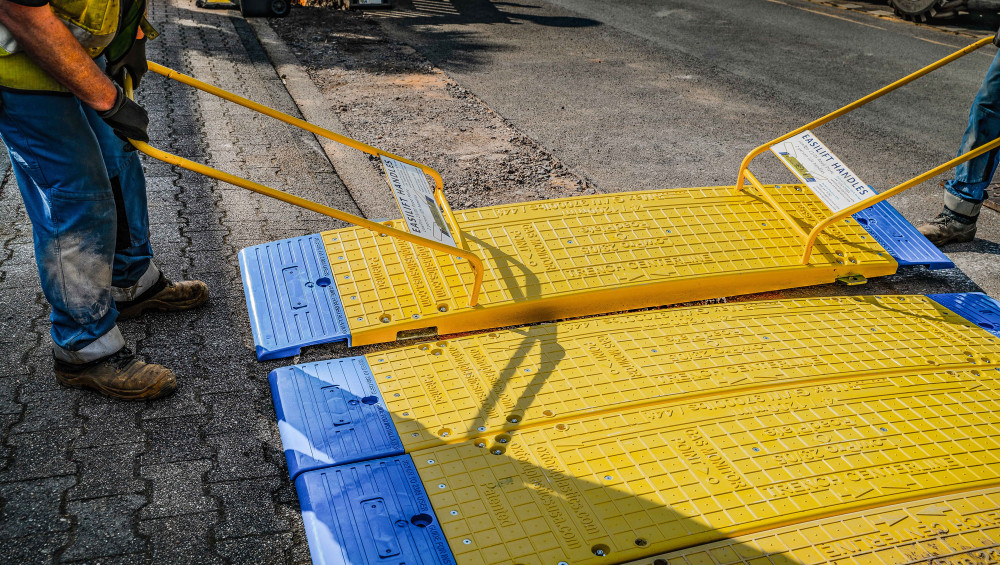A Contractor's Guide to Trench Safety Compliance (And Avoiding Costly Mistakes)

Trench safety compliance is more than a box-ticking exercise; it protects lives, keeps your projects running, and saves you from major costs down the line.
In this guide, we will break down the essential trench safety rules, common hazards, and the practical steps contractors and site managers can take to stay compliant and keep teams safe.
What Is Trenching Safety and Why Does It Matter?
Trench safety refers to the rules, systems, and behaviors that prevent cave-ins, falls, and other trench hazards. According to OSHA (Occupational Safety and Health Administration), trench collapses are among the deadliest incidents on construction sites, with cave-ins posing a particular risk to operations in unprotected trenches.
OSHA US states that trenches over 5ft (1.5m) deep must have protective systems in place unless the excavation is made entirely in stable rock.
Not following trench safety regulations can lead to:
- Worker injuries and fatalities
- Costly project delays
- Legal penalties and HSE/OSHA investigations
- Damaged reputation and lost contracts
Who Oversees the Safety of Workers in a Trench?
Responsibility ultimately lies with the contractor or site manager. Under CDM Regulations in the UK and OSHA in the US, duty holders must ensure that trenching activities are properly planned, supervized, and carried out by competent people.
Supervision should involve regular inspections, risk assessments, and ongoing training to ensure that workers understand the risks and are equipped to follow safe practices.
Key Hazards in Trenching

OSHA Trench Safety Guidelines
The main OSHA trench safety rules include:
- A competent person must inspect trenches daily and after any change in conditions.
- Protective systems like shoring, shielding, benching, or sloping must be used to prevent collapses.
- Access and egress points (ladders, ramps) are needed within 25 feet of all workers in trenches 4 feet deep or more.
- Soils must be properly classified, and all equipment/materials kept at least 2 feet from the edge.
OSHA also runs Trench Safety Stand Down Week annually to promote awareness and reduce trench-related fatalities.
For more on OSHA trenching standards, visit: https://www.osha.gov/trenching-excavation
How to Stay Trench Safety Compliant: in 5 Key Steps
1. Always plan ahead
Start with a risk assessment. Identify the type of soil, depth, location of utilities, and environmental risks before digging.
2. Install protective products
Use trench covers, shoring, sloping, or benching to prevent collapses. The method chosen depends on soil type and trench depth.
3. Inspect trenches daily
A competent person must inspect trenches at the start of each shift and after any weather events or changes.
4. Train your team
Make sure that all workers are trained in trench hazards, escape procedures, and emergency response.
5. Use ground protection
Install trench covers or ground protection mats to reduce surface damage, prevent falls, and ensure safe access. Learn more about Oxford Plastics' trench cover systems.
Real World Consequences of Non-Compliance
In recent years, contractors have faced six-figure fines, prison sentences, and tragic fatalities due to preventable trench collapses.
One report from OSHA stated that 80% of trench fatalities occurred in trenches less than 5 meters long – this is often because safety procedures were skipped on "small" jobs.
Safer Sites Start with Smarter Products
At Oxford Plastics, we provide a wide range of trench cover systems and ground protection mats that support safe, compliant trenching.
Our solutions are:
- Lightweight but strong
- Designed for pedestrian and vehicle traffic
- Compliant with UK and US safety standards
- Built to last with durable, high-performance materials
- Made with sustainability in mind to support greener worksites
- Easy to install and reposition, saving time on site
- Mats can be customized with corporate logos and colors. MOQs apply.
Explore our full range of LowPro® Trench Covers and Ground Protection Mats – including the industry-leading LowPro 15/10 – designed to support safe trenching and keep your site compliant in both the UK and US to support you and your team's safety.
FAQs
What is trench safety?
Trench safety refers to systems and practices that prevent accidents like cave-ins, falls, or hazardous atmospheres during excavation work.
Are trench covers mandatory?
Not always, but they are highly recommended to prevent injuries and support site safety, particularly for pedestrian areas.
Can ground protection mats improve trench safety?
Yes, they help prevent surface damage, support access, and minimize trip and fall hazards. Need help choosing the right trench safety solution? Get in touch with our team or explore our safety products today.
Related News

An Industry Guide to LowPro Road Plates and Trench Covers
Across construction and utilities in gas energy, waste-water, water suppy and fibreoptic works, keeping people safe and sites...

Protecting History: LowPro 15/05 Road Plate at St Catherine's College
We all know that renovating a listed building is never straightforward, especially when that building is a modern architectur...

The Kit List That Keeps Your Team Safe (and You Covered)
When it comes to running a safe, compliant, and efficient site, the right kit can make all the difference. From managing foot...